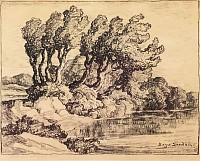BIOGRAPHY

1871-1954
Born Blidsberg, Sweden, Feb. 5, 1871; died Lindsborg, June 19, 1954. Painter, specialized in landscapes. Etcher. Engraver. Lithographer. Teacher. Attended the College and Academy of Skara as a pupil of Olof Erlandsson.
After graduation from Skara College, Sandzén spent a semester at Lund University attending art history lectures and continuing the study of French. Following Lund University he went to the technical high school at Stockholm, where he studied perspective and form drawing.
Sandzén joined a group of young artists and they rented a studio at Anders Zorn's suggestion. They received instruction from Zorn as well as Richard Bergh, a well-known portrait painter and Per Hasselberg, one of Sweden's best sculptors.
Sandzén then went to Paris to study with Aman Jean, where he began to associate with American students in the French studies. On returning home in 1894, a family friend sent Sandzén a booklet about Bethany College, Lindsborg and the town called "Little Sweden." Sandzén moved to Lindsborg in 1894 to teach French, voice, art history, drawing and painting at Bethany College where he remained on the faculty until 1946.
He first painted in the Colorado Springs, CO area in 1916, and became a frequent visitor to Santa Fe and Taos, NM beginning in 1918. Sandzén spent the summers of 1923-24 teaching at the Broadmoor Academy in Colorado Springs (presently the Colorado Springs Fine Arts Center). Sandzén also taught at Chappell House (the forerunner to the Denver Art Museum), Utah State Agricultural College, Stephens College, the University of Michigan, and the 188 Kansas City Art Institute.
Sandzén's style of painting is unusual in its thick and heavy application of impasto in bold and bright color combinations, interpreting the landscape of the western United States. He is known for very colorful renderings of mountain lakes with boulders, cypress and aspen trees and moonrises along waterways.
Sandzén was an important advocate for art in the region, spending time talking to people about art, organizing exhibitions and establishing art clubs. He donated artwork to the local art club to help raise money for the purchasing of art books for the library, the financing of exhibitions, and the occasional awarding of a scholarship.
He painted murals for the Halstead Post Office, Where Kit Carson Camped, in 1941, for the Lindsborg Post Office, Smoky River, in 1938, and for the Belleville Post Office, Kansas Stream, in 1939. He illustrated three books, With Brush and Pencil (1905), In the Mountains, (1925), The Smoky Valley, (1922).
